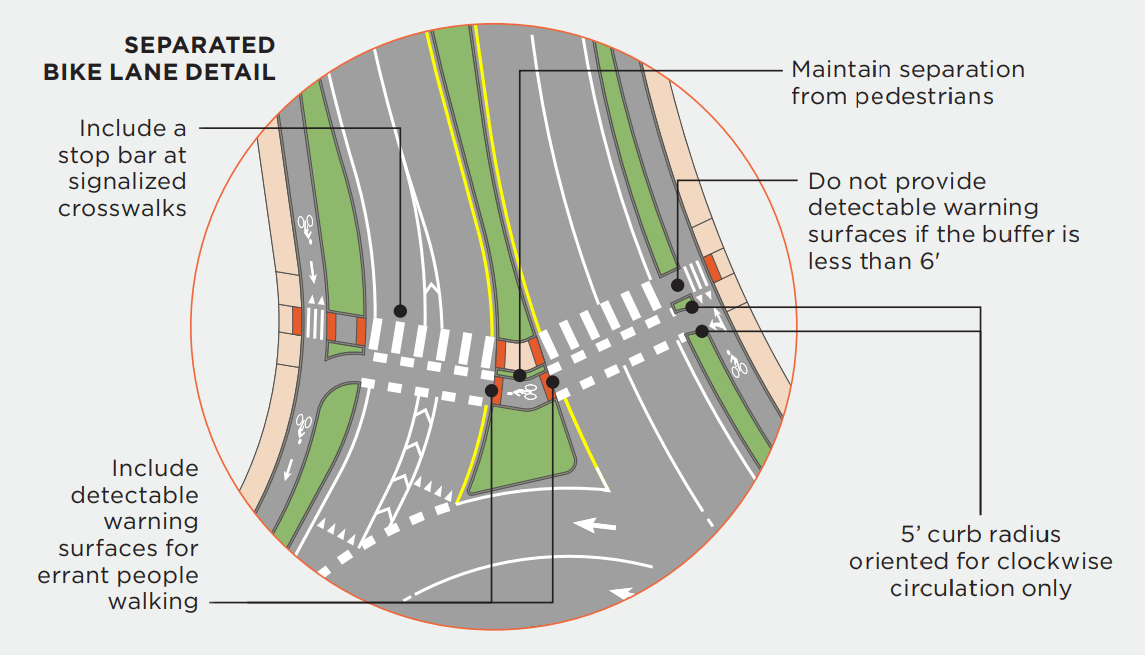September 13, 2024
The greatest conflicts for people on bikes typically come at intersections—and that includes roundabouts. Designing roundabouts to better accommodate the full spectrum of bicycle riders (“the 8- to the 80-year-old”) is part of a broader movement to make intersections safer and more comfortable for bicyclists, since we know that one stressful intersection or crossing can be enough to dissuade someone from choosing to bike to their destination.
Historically, bicyclists at roundabouts have been encouraged to take the travel lane like a vehicle would. However, while this can usually work on single-lane roundabouts, it can create conflicts and an uncomfortable experience for bicyclists (and drivers) on multilane roundabouts.
Roundabout designs have also typically provided an option for bicyclists to exit the approach lane using a bicycle ramp and then take a shared-use path around the roundabout. This separates them from people driving, which is arguably the most concerning conflict, but puts them in the same space as people walking.

Historically, bicyclists at roundabouts have been encouraged to take the travel lane, with the option to exit onto a shared-use path.
New Guidance for Bicycle Facilities at Roundabouts
NCHRP Research Report 1043: Guide for Roundabouts, which came out in June 2023 and superseded the previous national roundabout guide, included updated guidance on designing for bicyclists at roundabouts that takes a page out of the European roundabout playbook. In many Dutch roundabouts, bicyclists can still take the travel lane if desired, but also have the option to take a separated bike lane around the entire roundabout. The new US roundabout guide provides roundabout designs where people driving, biking, and walking each have a dedicated space for navigating the intersection.
This revamped guidance is part of a growing emphasis on providing protected bicycle facilities in high-conflict areas and on high-speed roads. But this evolution must take place one street and one intersection at a time, begging the question: how can we design roundabouts to flow with our existing networks, while also setting them up to complement more protected bike lanes in the future? For example, what if the approach lanes don’t have protected bicycle lanes yet? The roundabout designer faces a challenge of tying together a variety of existing bicycle facilities (or lack thereof) while incorporating new best practices so that the roundabout doesn’t become the reason someone chooses not to bike on that street, or bike at all.
Thankfully, there are a growing number of resources that provide concepts and specifications for navigating these exact situations. One such publication is MassDOT’s Guidelines for the Planning and Design of Roundabouts, which includes design principles and options for providing bicyclist safety, comfort, and connectivity, including a framework for selecting a bicycle facility for your roundabout design.

Figure 5-16 of MassDOT’s roundabout guide shows a design with a separated bike lane.
This guide emphasizes that bicycle facilities around roundabouts should meet or exceed the safety and comfort levels bicyclists experience on the approach legs (or will experience in the future, if protected bike lanes are not yet constructed)—going back to the idea that the way we design intersections is critical for bicyclist safety, and to encourage more people to choose this mode of travel.
Updated Roundabout Guidance in Action: Powder House Square
A built example of a separated bike lane around a roundabout (or in this case, a traffic circle, due to a stop sign installed for safety reasons) is Powder House Square in Somerville, Massachusetts. Prior to its conversion to a traffic circle, Powder House Square was a convoluted convergence of six two-way streets, with no defined path of travel for bicyclists. Today, the traffic circle features a well-defined single-traffic lane and a separated bike lane around the perimeter. See how it works at the video below:
The bike lane is separated from vehicle traffic all the way around the traffic circle, except where drivers cross the lane when entering or exiting—but as you can see, the crossings were designed to increase drivers’ visibility of people walking and biking when they come to those points.
Continue the Conversation
This is an ever-evolving topic, and we invite you to reach out with your questions and ideas! Join our celebration of National Roundabouts Week by perusing more roundabout-related content at the links below:
What’s New in the New Roundabout Guide?
How Many Roundabouts Are in the United States?
Overcoming the Fear of the Roundabout
How to Tap into the Value of the Roundabouts Database
